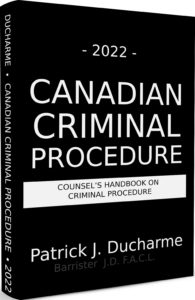
Part XVI of the Code dealing with judicial interim release, the formal description of bail, also applies to a young person with some sensible alterations. Section 28 provides that “except to the extent that they are inconsistent with or excluded by this Act, the provisions of Part XVI (compelling appearance of an accused and interim release) of the Code apply to the detention and release of young persons under this Act.” For one to argue that the provisions that govern adults in relation to bail should not apply to a young offender it must be demonstrated that that the particular provision is inconsistent with or excluded by the YCJA.
In considering whether detention is necessary for a young person for the “protection or safety of the public” under subsection 515(10)(b) of the Code, the secondary ground of detention, a Youth Justice Court is required to presume that detention is not necessary if the young person could not, on being found guilty, be committed to custody. Thus, the court may not detain a young person on the secondary ground of detention unless:
(a) the young person has been charged with
(i) a serious offence, or
(ii) an offence other than a serious offence, if they have a history that indicates a pattern of either outstanding charges or findings of guilt;
(b) the Judge or Justice is satisfied, on a balance of probabilities,
(i) that there is a substantial likelihood that, before being dealt with according to law, the young person will not appear in court when required by law to do so,
(ii) that detention is necessary for the protection or safety of the public, including any victim of or witness to the offence, having regard to all the circumstances, including a substantial likelihood that the young person will, if released from custody, commit a serious offence, or
(iii) in the case where the young person has been charged with a serious offence and detention is not justified under subparagraph (i) or (ii), that there are exceptional circumstances that warrant detention and that detention is necessary to maintain confidence in the administration of justice, having regard to the principles set out in section 3 and to all the circumstances, including
(A) the apparent strength of the prosecution’s case,
(B) the gravity of the offence,
(C) the circumstances surrounding the commission of the offence, including whether a firearm was used, and
(D) the fact that the young person is liable, on being found guilty, for a potentially lengthy custodial sentence; and
(c) the Judge or Justice is satisfied, on a balance of probabilities, that no condition or combination of conditions of release would, depending on the justification on which the Judge or Justice relies under paragraph (b),
(i) reduce, to a level below substantial, the likelihood that the young person would not appear in court when required by law to do so,
(ii) offer adequate protection to the public from the risk that the young person might otherwise present, or
(iii) maintain confidence in the administration of justice.
Section 31 of the YCJA provides that a young person who has been arrested may be placed in the care of a responsible adult instead of being detained in custody. So, even where the court finds that the detention of the young person is necessary, if there is a responsible adult willing to care for the young person then he or she may be released from detention into the adult’s care. The Youth Justice Court must be satisfied that the responsible adult is willing and able to take care of and exercise control over the young person and the young person is willing to be placed in the care of the adult.

The above is the an excerpt of Patrick J Ducharme’s book, Canadian Criminal Procedure, available at Amazon or in bulk through MedicaLegal Publishing along with Criminal Trial Strategies.
Subscribe to Patrick Ducharme’s Youtube Channel
